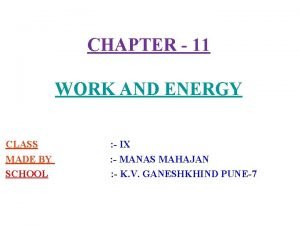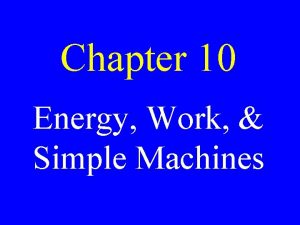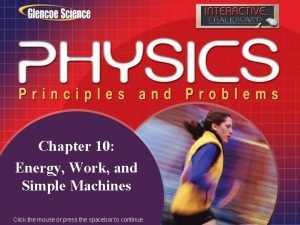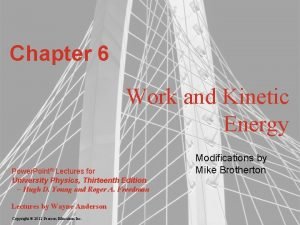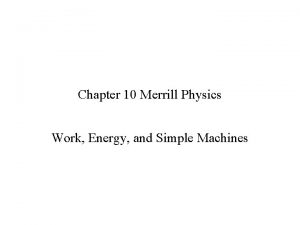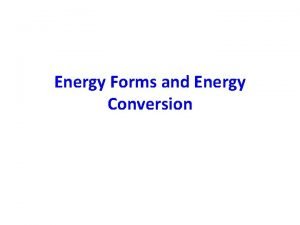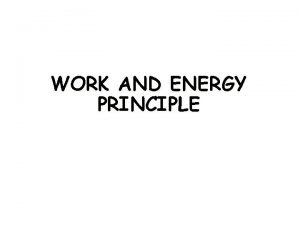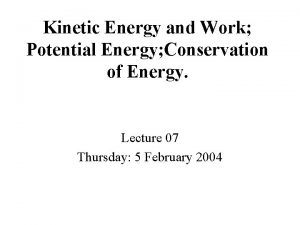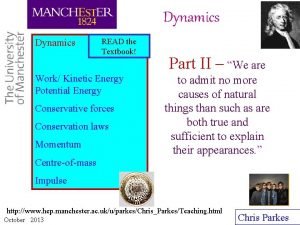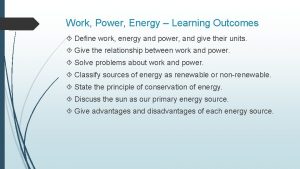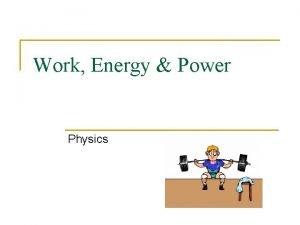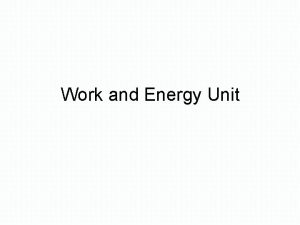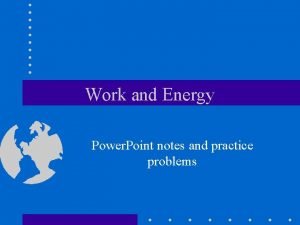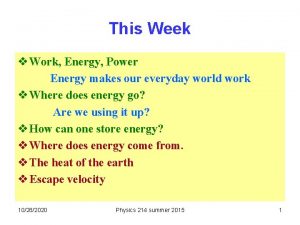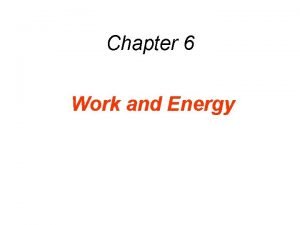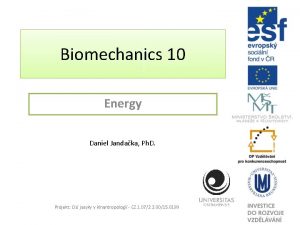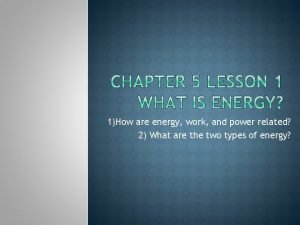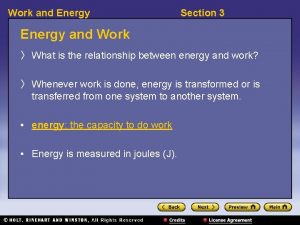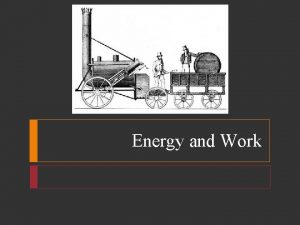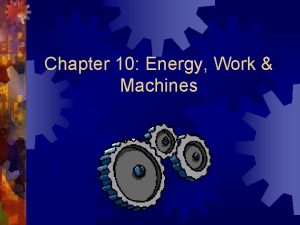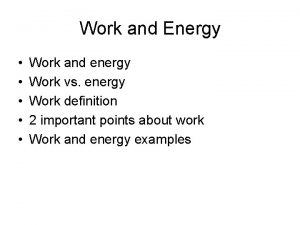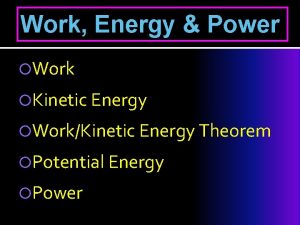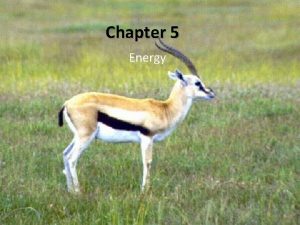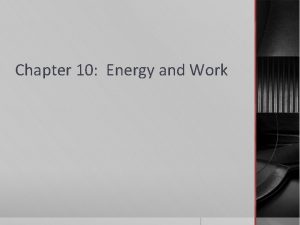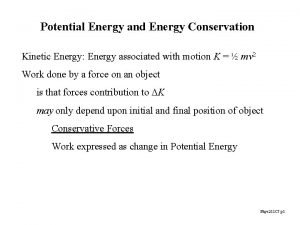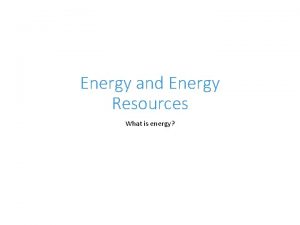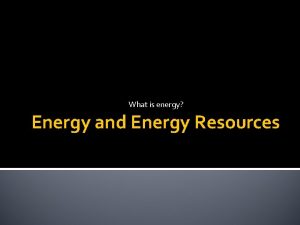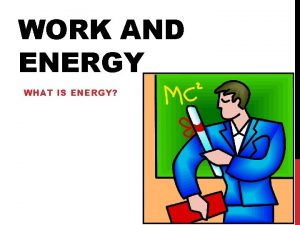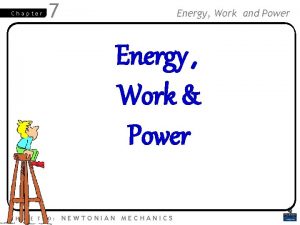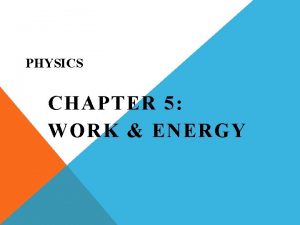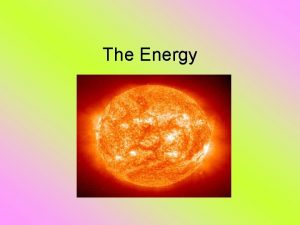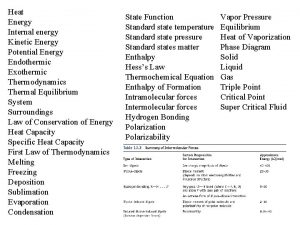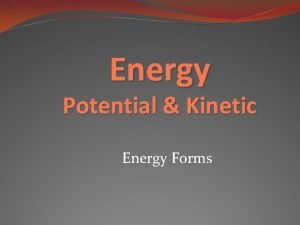WORK AND ENERGY PS Chapter 4 Work Work








































- Slides: 40

WORK AND ENERGY PS Chapter 4

Work ■ Work is a product of the force applied and the distance over which the work is applied – W=Fd – In order for work to have been done, the object receiving the force must move ■ Proof (very , very likely to be on your test…) – W=Fd, If the object does not move, d=0 ■ W=F(0)=0 – No work is done

Deriving the Units for Work ■ W=Fd – W(? )=F(N)xd(m) – W=N*m – Recall that N=kg*m/s 2 – So, W=kg*m/s 2*m=kg*m 2/s 2 ■ We have a name for this unit – Called Joule (J) – 1 J=1 kg*m 2/s 2 ■ As you will see, Joules are the unit for energy – To do work, you must expend energy

Example problem-Work ■ You and a friend are driving when you run out of gas 100 m from the nearest gas pump. To get the car to the gas pump, you put the car in neutral and together push with 1080 N to the gas pump. How much work did the two of you do? ■ 2. 4 x 105 J

Practice #1 ■ You apply a force of 60 N to an object to move it 5 m. How much work did you do? ■ 300 J

Practice #2 ■ Your lazy friend sits in a chair on wheels and asks you to push them to their next class which is 10 m away. You agree to do so as long as they pay you $1 per Joule expended. They accept because they were not paying attention in class and have no idea what you are talking about. You push on the chair with a force of 400 N to their class. How much do they owe you? ■ $4000

Practice #3 ■ An object has a mass of 100 kg. You push on the object for 30 m it accelerates at 2 m/s 2. How much work did you do on the object? ■ 6000 J

Machines ■ Any object that changes the force or increases the motion from work – The purpose of a machine is to make work easier ■ 6 simple machines – Lever, pulley, screw, inclined plane (ramp), wheel and axle, wedge

Compound Machines ■ A combination of 2 or more simple machines

Efficiency ■

Example Problem-Efficiency ■ What is the efficiency of a machine that can move a 50 J object when 100 J of force are applied? ■ 50%

Practice #1 ■ You do 100 J or work. If the output work is 20 J, what is the efficiency of the machine? ■ 20%

Practice #2 ■ A machine is 50% efficient. If you input 40 J of work, what will be the machine’s output work? ■ 20 J

Practice #3 ■ An electric motor is used to life a 0. 412 kg mass 1 meter off of the floor. If the machine requires an input of 10 J of energy, what is the efficiency of the machine? ■ 40%

Mechanical Advantage ■ How much a machine increases force. ■ Machines change the way that work is done. – Ideally, the machine will trade a certain amount one aspect of movement in order to achieve more force ■ 3 types of mechanical advantage: – Force mechanical advantage – Distance mechanical advantage – Speed mechanical advantage

Force MA ■

Speed and Distance MA ■ Similar concept to force MA – Trade off one aspect of movement in order to achieve an increase in the desired movement

What Mechanical Advantage Means ■ Mechanical Advantage can be any positive number – IF MA=1, force is not increased ■ Direction or speed can be changed though – If MA>1, force is increased by the machine – If MA<1, the machine requires more force than it outputs ■ The machine is still useful, but increases distance at the expense of force

Example Problem-Mechanical Advantage ■ After months of your parents asking you to do so, you finally sweep the floor. To move the broom, you input 3 N of force. The broom moves with a force of 1 N on the floor. What is the mechanical advantage of the broom? ■. 3 – Less than one, so it decreases the force. ■ However, the broom moves a greater distance than you move your hand.

Practice #1 ■ You apply a force of 10 N to a crowbar to pry open a door that has a resistance force of 600 N. What is the mechanical advantage of the crowbar? ■ 60 – Greatly increases the force.

Practice #2 ■ You do 150 J of work to move the handle of a car jack a total distance of 10 m. The jack lifts the 2000 kg car with an acceleration of. 1 m/s 2. What is the mechanical advantage of the jack? ■ 13. 3

Energy ■ The ability to do work or cause a change to the system ■ Can be transferred, or changed to different forms ■ Several forms: – Mechanical energy-The sum of the kinetic and potential energy of a system – Electrical energy – Chemical energy – Radiant energy – And more

Kinetic Energy ■

Example Problem-Kinetic Energy ■ What is the kinetic energy of a 1000 kg car moving at 100 m/s? ■ 5 x 106 J

Practice #1 ■ What you throw a 5 kg ball at 10 m/s to your friend. What is its kinetic energy? ■ 250 J

Practice #2 ■ A student with a mass of 60 kg walks down the hall at 3 m/s. What is their kinetic energy? ■ 270 J

Practice #3 ■ An object moving north has a mass of 10 kg. If it has kinetic energy of 10, 000 J, what is its velocity? ■ 44. 7 m/s north

Potential Energy ■ Stored energy ■ Energy that has the ability (potential) to change forms ■ Due to interactions between objects ■ Different Types: – Elastic Potential Energy ■ Energy stored by stretching or squeezing (rubber band, stress ball) – Chemical Potential Energy ■ ■ Energy stored in chemical bonds Energy is released when the bonds are broken, and become available for other activities – Gravitational Potential Energy ■ Energy due to gravitational attraction between objects – Ex. Apple on tree and ground

Gravitational Potential Energy (GPE) ■

Example Problem: GPE ■ A 4 kg textbook rests on a shelf 2 meters from the floor. What is the book’s GPE relative to the floor? What is the GPE relative to the shelf? ■ 78. 4 J relative to the floor ■ 0 J relative to the shelf

Practice #1 ■ What is the GPE of a 10 kg object 40 m from the floor, relative to the floor? ■ 3920 J

Practice #2 ■ What is the GPE of a ceiling fan with a mass of 12 kg that is handing ½ meter from the ceiling if the room is 4 meters tall? ■ 411. 6 J

The Law of Conservation of Energy ■ Energy cannot be created or destroyed ■ It can, however, change forms – And does often ■ Example: Roller coaster – At the top of the high hill, GPE is high and KE is low – As the car moves over the hill and begins to speed up, KE increases because velocity increases ■ At the same time, height is decreasing so GPE decreases – At the end of the ride, the cart stops, transforming KE (movement) to thermal energy (heat) due to friction

Mechanical Energy ■ The sum of the kinetic and potential energy of a system ■ It is the energy related to the motion and position of an object – Includes KE, GPE, and elastic potential energy – Does not include nuclear energy, thermal energy, or chemical potential energy ■ The mechanical energy and total energy are not necessarily the same – Therefore, mechanical energy is not necessarily conserved ■ Total energy is though – Always

Transformations of Energy ■ Objects in motion lose energy to their surroundings as heat – This lost energy is called thermal energy (the energy of heat) ■ Electric energy can also be transformed to thermal energy (heat) and radiant energy (light) – Light bulb ■ Fuel (chemical energy) can be transformed into mechanical energy ■ Radiant energy (sunlight) can be transformed into chemical potential energy (sugars in food) and that can be transformed into the energy needed to do everyday tasks – Breathing, heart beating, etc.

Power ■

Example Problem: Power ■ A lightbulb transforms 600 J of energy from electricity to radiant and thermal energy in 10 seconds. What is its power? ■ 60 W

Practice #1 ■ How much energy does a 100 W bulb convert to other forms in 10 minutes? ■ 1000 J

Practice #2 ■ You do 100 J of work in 10 seconds. What is your power> ■ 10 W

Practice #3 ■ You accelerate a 10 kg object at a rate of 2 m/s 2 over a distance of 300 m. It takes you 60 seconds. What is your power? ■ 100 W
 Chapter 4 section 1 work and machines answer key
Chapter 4 section 1 work and machines answer key Energy energy transfer and general energy analysis
Energy energy transfer and general energy analysis Energy energy transfer and general energy analysis
Energy energy transfer and general energy analysis Describing energy section 2 answers
Describing energy section 2 answers Physics 03-02 potential energy and conservative forces
Physics 03-02 potential energy and conservative forces Chapter 11 work and energy
Chapter 11 work and energy Chapter 10 energy, work and simple machines answer key
Chapter 10 energy, work and simple machines answer key Chapter 10 energy, work and simple machines answer key
Chapter 10 energy, work and simple machines answer key Energy work and simple machines chapter 10 answers
Energy work and simple machines chapter 10 answers Chapter 6 work and energy powerpoint
Chapter 6 work and energy powerpoint Physics 10
Physics 10 Chapter 7 energy conservation of energy
Chapter 7 energy conservation of energy Primary energy and secondary energy
Primary energy and secondary energy Disadvantages of conventional energy
Disadvantages of conventional energy Helmholtz free energy
Helmholtz free energy Renewable energy and energy efficiency partnership
Renewable energy and energy efficiency partnership Definition of kinetic energy
Definition of kinetic energy Potential energy of spring
Potential energy of spring Formula of potential energy
Formula of potential energy Kinetic energy and potential energy formula
Kinetic energy and potential energy formula Eroei
Eroei Principle of work and kinetic energy
Principle of work and kinetic energy Kinetic energy proof
Kinetic energy proof Chart on work and energy
Chart on work and energy Work done by friction formula
Work done by friction formula Learning outcomes of work and energy
Learning outcomes of work and energy Sound energy definition
Sound energy definition How many types of energy
How many types of energy Work, power and energy activities
Work, power and energy activities W= f d cos theta
W= f d cos theta Work and energy powerpoint
Work and energy powerpoint Work energy power
Work energy power Work and energy
Work and energy Energy enables you to work and play
Energy enables you to work and play Is thrust a conservative force
Is thrust a conservative force Work defined in physics
Work defined in physics Jandaka
Jandaka How are work and power related
How are work and power related Work and energy section 2
Work and energy section 2 Work power energy and machines
Work power energy and machines W=fdcosθ meaning
W=fdcosθ meaning





